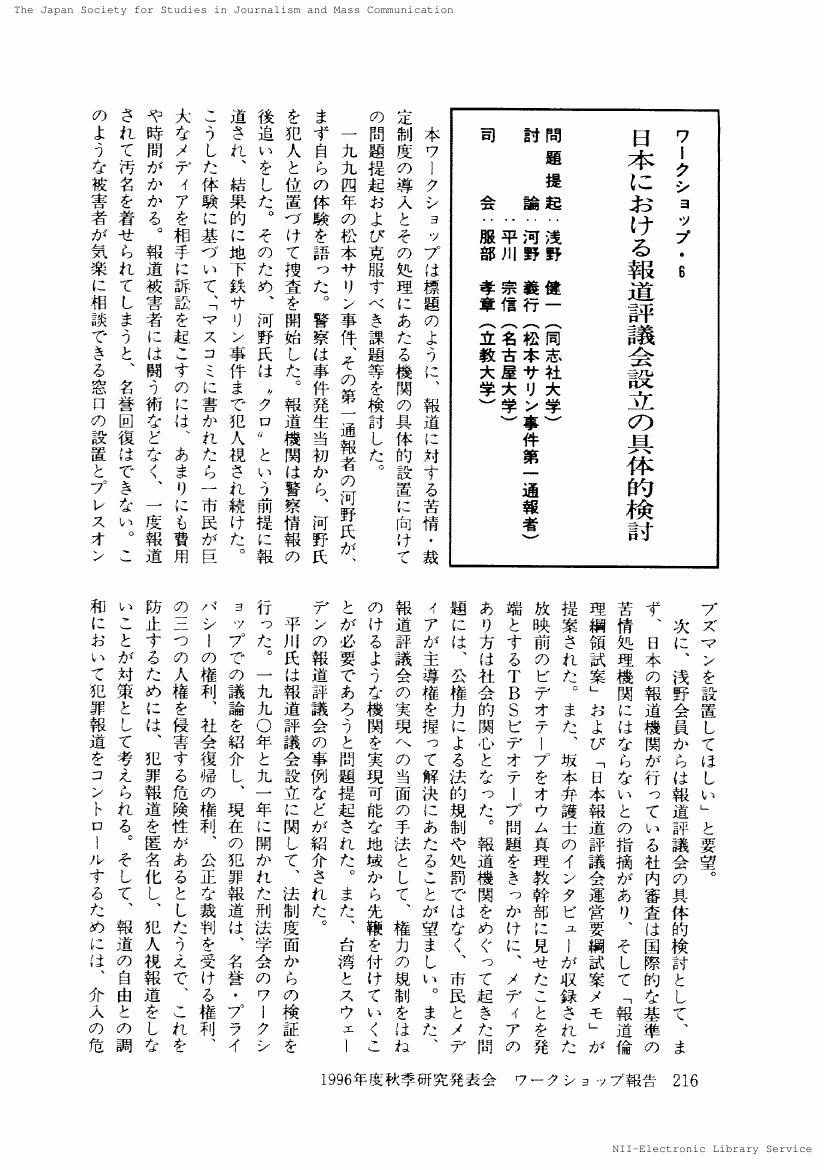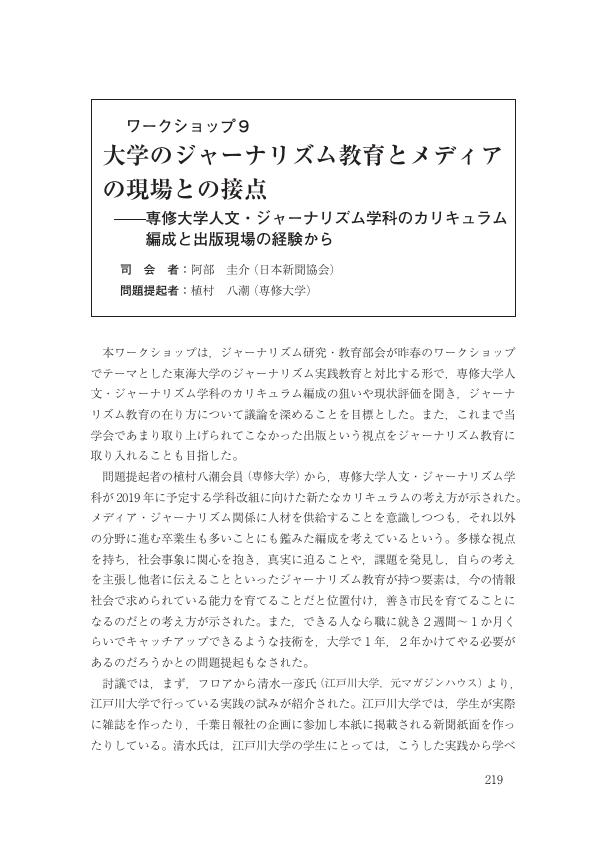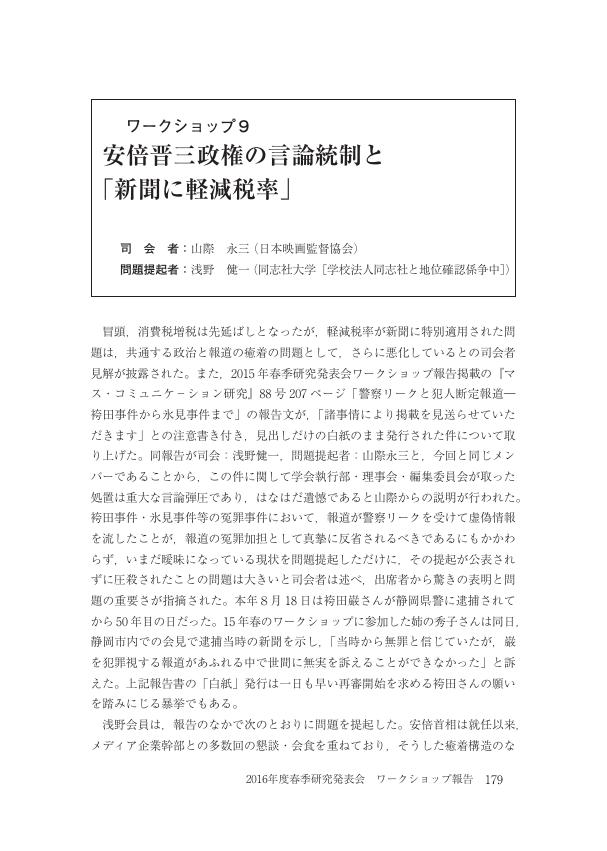1 0 0 0 OA 明治中期迄の写真舗顧客と写真蒐集家斎藤月岑 : 写真の大衆化の「受け手」論的一考察
- 著者
- 緒川 直人
- 出版者
- 日本マス・コミュニケーション学会
- 雑誌
- マス・コミュニケーション研究 (ISSN:13411306)
- 巻号頁・発行日
- vol.82, pp.251-271, 2013-01-31 (Released:2017-10-06)
- 参考文献数
- 23
This paper examines photo carte-shop customers' experience of buying photographs and the chain reaction mediated by such experience from the perspective of recipient analysis in the study of media history. The study's objective is to clarify the process through which photography became popular around the middle of the Meiji Era. An analysis of photo studio customer behavior was made through materials such as newspapers, diaries, photo albums and other resources. Photography was popularized by two phenomena. First was the communication enjoyed when seeing photographs displayed at photo carte-shops or seeing photographs at home, as well as the game of guessing who appeared in photographs. Second, there was the spread and chain behaviors of customer experience described in the photo collections and the writings on the history of photography by famous collector Gesshin Saito. His writing in Shashinkyo (History of Photo carte-shops) proposed a new historical perspective and method of the study of history of photographs in Japan.
1 0 0 0 OA 日本における報道評議会設立の具体的検討(一九九六年度春季研究発表会 ワークショップ報告)
- 著者
- 浅野 健一 河野 義行 平川 宗信 服部 孝章
- 出版者
- 日本マス・コミュニケーション学会
- 雑誌
- マス・コミュニケーション研究 (ISSN:13411306)
- 巻号頁・発行日
- vol.50, pp.216-217, 1997-01-31 (Released:2017-10-06)
1 0 0 0 警察リークと犯人断定報道:袴田事件から氷見事件まで
- 著者
- 浅野 健一
- 出版者
- 日本マス・コミュニケーション学会
- 雑誌
- マス・コミュニケーション研究 (ISSN:13411306)
- 巻号頁・発行日
- vol.96, pp.203-204, 2020
1 0 0 0 OA ワークショップ11 新聞・放送業界の新人採用と大学のメディア教育の「ギャップ」を考える
- 著者
- 水島 久光
- 出版者
- 日本マス・コミュニケーション学会
- 雑誌
- マス・コミュニケーション研究 (ISSN:13411306)
- 巻号頁・発行日
- vol.90, pp.183-185, 2017-01-31 (Released:2017-10-06)
- 著者
- 阿部 圭介
- 出版者
- 日本マス・コミュニケーション学会
- 雑誌
- マス・コミュニケーション研究 (ISSN:13411306)
- 巻号頁・発行日
- vol.92, pp.219-220, 2018-01-31 (Released:2018-05-10)
- 著者
- 五十嵐 浩司
- 出版者
- 日本マス・コミュニケーション学会
- 雑誌
- マス・コミュニケーション研究 (ISSN:13411306)
- 巻号頁・発行日
- vol.89, pp.131-132, 2016-07-31 (Released:2017-10-06)
1 0 0 0 OA ワークショップ7 報道組織が求める「優秀な人材」とジャーナリズムの今後を考える
- 著者
- 谷岡 理香
- 出版者
- 日本マス・コミュニケーション学会
- 雑誌
- マス・コミュニケーション研究 (ISSN:13411306)
- 巻号頁・発行日
- vol.91, pp.156-157, 2017-07-31 (Released:2017-11-07)
- 著者
- 山本 昭宏
- 出版者
- 日本マス・コミュニケーション学会
- 雑誌
- マス・コミュニケーション研究 (ISSN:13411306)
- 巻号頁・発行日
- vol.79, pp.153-170, 2011-07-31 (Released:2017-10-06)
- 参考文献数
- 7
This paper analyzes articles about nuclear energy in three science magazines, Kagaku Asahi (Asahi Science), Shizen (Nature), and Kagaku (Science), which were published in Japan in the 1950s. The analytical methodology used in the study is a combination of quantitative analysis and theory concerned with the agenda-setting function of the media. The study aims to reveal the relationship between the discourse found in the articles and Japanese opinions concerning nuclear energy development and radioactive substances, and to explore the qualitative changes in the discourse of the articles and the reasons underlying such changes. One conclusion that emerges from the quantitative analysis is that the number of discourses concerning nuclear energy increased between 1954 and 1955, and following this started to steadily decrease. Generally speaking, the Lucky Dragon 5 incident in 1954, in which the crew of a Japanese fishing vessel was exposed to nuclear fallout from US nuclear testing on Bikini Atoll, is considered to have started the anti-nuclear movement in Japan. At this time, in the science magazines, there was an increase in specialist discourses concerning topics such as nuclear reactors and methods of measuring nuclear fallout. In reality, almost all the scientists involved in nuclear energy research and development thought that they had no connection to the anti-nuclear movement. Based on a purely dualistic conception of good and bad, they continued to position nuclear energy as something to be used for good. From this perspective, it can be seen that in the Japanese science magazines of the 1950s, the nuclear bombing of Hiroshima and Nagasaki and its effects were understood only in a very limited sense.
1 0 0 0 OA 雑誌モデル・ファンのエスノグラフィー: 「読書」空間とガールズイベントをめぐる経験から
- 著者
- 佐々木 孝侍
- 出版者
- 日本マス・コミュニケーション学会
- 雑誌
- マス・コミュニケーション研究 (ISSN:13411306)
- 巻号頁・発行日
- vol.81, pp.163-180, 2012-07-31 (Released:2017-10-06)
- 参考文献数
- 26
In recent years, models on fashion magazines have become highly popular in Japan. Such popularity finds its explanation in the enthusiastic behavior of fans as can be noticed in big fashion events such as "Tokyo Girls Collection". This paper ethnographically describes the phenomenon of the behavior of models' fans. In order to understand their interpretation and feelings about fashion models, the author conducted a semi-structural survey asking eighteen women about their most favorite models in 2011. This paper also looks into how fashion magazines, the place of activity for models, are perceived by the fans. The participants' observation at girls' events has also been assessed. The findings of the research can be stated as follows. According to fans, fashion magazines constitute a source of information about models. In fact, the attention of fans goes straight to the features of the body, the face or to the hairstyle of models. The models' fans do not interact with each other as is usually the case. Fans are not really interested in the personality or the private life of models. The paper shows however that at girls' events, the fans are more attracted by the features of the body.
- 著者
- 新藤 雄介
- 出版者
- 日本マス・コミュニケーション学会
- 雑誌
- マス・コミュニケーション研究 (ISSN:13411306)
- 巻号頁・発行日
- vol.88, pp.97-115, 2016
This study aims to examine speech before and after the enforcement of the assembly ordinance. The current study hopes to reveal the political and academic aspects of speech, within both the printed word and oral forms, in relation to the Movement for Civil Rights and Freedom of the 1880s. Speeches were delivered in meetings across the country under the influence of the Diet-establishing movement. The Government of Japan enacted the assembly ordinance in an attempt to prevent the movement. This law targeted political speech, not academic speech, and as such, a problem occurred with what was deemed a "political" subject. In addition, there was a vague range in terms of application of the law and arbitrary enforcement standard. Those who wanted to make a speech found a way to circumvent political speech in terms of form. Therefore, people made academic speeches, held social gatherings, and meetings to comment on newspapers, instead of giving political speeches. However, political speeches were, in fact, delivered in these "non-political" meetings. Police often cracked down on these meetings. Differences between the political and the academic forms led to discussions on the rights and wrongs of speech based on the publications at the time. In particular, in meetings for commentary on newspaper articles, the police did not prohibit the publication of newspapers, but prohibited speech related to newspaper content. The court in the first trial brought in a verdict of not guilty, but the Supreme Court later gave a guilty verdict. This demonstrated the ambiguity of political speech in the law. At the same time, it indicated that people were being arrested for speaking about newspaper content although the same content had already been circulated in print. The administration banned the use of schools as platforms for speeches, and teachers from making them.
1 0 0 0 OA ワークショップ9 安倍晋三政権の言論統制と「新聞に軽減税率」
- 著者
- 山際 永三
- 出版者
- 日本マス・コミュニケーション学会
- 雑誌
- マス・コミュニケーション研究 (ISSN:13411306)
- 巻号頁・発行日
- vol.90, pp.179-180, 2017-01-31 (Released:2017-10-06)
1 0 0 0 OA なぜ「メディア文化研究」なのか(<特集>メディア文化研究の課題と展望)
- 著者
- 難波 功士
- 出版者
- 日本マス・コミュニケーション学会
- 雑誌
- マス・コミュニケーション研究 (ISSN:13411306)
- 巻号頁・発行日
- vol.78, pp.19-33, 2011-01-31 (Released:2017-10-06)
- 参考文献数
- 15
In this paper I insist the increasing value of adopting media cultural studies, after I defined the media culture as peoples' ways of life surrounding by media based on the relative decline of situation of mass communication recently. And then as well as media cultural studies will refer to the recent condition of media actually, based on much wider perspective, I unfold the consideration about the essence of media and I also offer an opinion that they progresses by becoming both wheels.
- 著者
- 玉川 博章
- 出版者
- 日本マス・コミュニケーション学会
- 雑誌
- マス・コミュニケーション研究 (ISSN:13411306)
- 巻号頁・発行日
- vol.87, pp.59-76, 2015-07-31 (Released:2017-10-06)
- 参考文献数
- 20
This paper studies the materiality of books in the publishing industry. Bearing in mind the criticism of the argument that books have materiality but electronic books do not, the authors examine the materiality of books by focusing on the following three themes: electronic books, book design and comics. The authors organize the concept of materiality used in discussions about books in order to show that unity with the content of books has great significance and the concept of materiality has been affected especially by the aspects of books as three-dimensional objects. Although electronic books do not fully reproduce the materiality of books in print, they have their own materiality, which has caused changes in expression in comics. The authors also show that the publishing industry has traditionally been built on materiality. The argument that emphasizes the materiality of books leads to the denial of publishing by mass replication. Finally, focusing on issues regarding value and prices in the media, the authors point out that arguments about the materiality of publication treat the value of text and that of material as unified, thereby revealing that materiality produces value.
- 著者
- 小林 義寛
- 出版者
- 日本マス・コミュニケーション学会
- 雑誌
- マス・コミュニケーション研究 (ISSN:13411306)
- 巻号頁・発行日
- vol.87, pp.3-15, 2015-07-31 (Released:2017-10-06)
- 参考文献数
- 26
In our daily lives we are surrounded by many "things." Therefore, for us the phenomena of the media and communications have been presented and represented in our everyday lives by the media itself or by "things" related to the media. However, while there has been much media research concerning "things" or "materiality," most of it did not analyze or consider in a manner that focused on the relationship between humans and non-humans. It means, in other words, this research did not consider "things" and "materials" as conditioned in specific situations. Recently, however, some research has concentrated its interest on both human and non-humans in the same situation and has been taking a variety of approaches that share three common characteristics among them. It takes de-human centrism, de-language centrism or de-text centrism and thirdly it equally presumes humans and non-humans as agencies or actors relative to these situations. In all five papers we attempted to show some approaches on "things" or "materiality" of the media. I have discussed that people will become an audience or fans by themselves in some specific situations. Not only have audiences never lived as a social existence by themselves but neither have fans. Humans become an audience or fans in the conditions where he or she and "things" exist. In other words he or she will become an audience or a fan with a variety of "things" in the conditions where he or she exists.
1 0 0 0 OA "みんな"の『みんなのうた』 : NHK音楽番組の生産・消費をめぐる一考察
- 著者
- 葉口 英子
- 出版者
- 日本マス・コミュニケーション学会
- 雑誌
- マス・コミュニケーション研究 (ISSN:13411306)
- 巻号頁・発行日
- vol.62, pp.116-133, 2003-01-31 (Released:2017-10-06)
The five-minute music program 'MINNA NO UTA' (Everyone's Songs), which has been broadcast on NHK since 1961, has contributed to the popularization of new children's songs. It has created about one thousand tunes, influencing musical education and popular music in Japan. This paper explores the characteristics and meanings of this program by focusing on its text as well as the processes of its production and consumption. My research involved conducting interviews with directors and distributing questionnaires to audiences. My aim is to explain the uses of this program by audiences through their everyday lives and how this TV program contributes to creating new children's songs. My conclusions are, firstly, that this program has a distinctive history that has been flexibly transforming songs into appropriate styles for children in the TV age. Secondly, these songs played a role in constructing a national collective identity for everyone (including grown-ups), especially from the 60s to the 80s, because these texts have functioned as 'national music' mediated by a state channel.
1 0 0 0 中井正一とコミュニケーションの双方向性
- 著者
- 後藤 嘉宏
- 出版者
- 日本マス・コミュニケーション学会
- 雑誌
- マス・コミュニケーション研究 (ISSN:13411306)
- 巻号頁・発行日
- vol.57, pp.122-137,212, 2000
Masakazu Nakai has been said to be a pioneer in the theory and practice of interactive communication in Japan. This article points out that, in Nakai's thought, there are two aspects in the relations of the intellectuals and the masses. One aspect he emphasized is the communicative equality of the intellectuals and the masses. The other aspect is the communicative priority of the intellectuals over the masses. This article remarks on his concept of 'Spannung'(tension). This concept is related to his dialectics. In the ordinary context, his dialectics transformed senders or speakers of communication and corresponded to'Mittel'. On the other hand, in the case of the dialectics of 'Spannung', senders of communication didn't have to transform, so 'Spannung'corresponded to'Medium'. In conclusion, Nakai equated'Mittel'with'Medium'.
1 0 0 0 《意味》への抗い : 中井正一の映画=メディア論をめぐって
- 著者
- 北田 暁大
- 出版者
- 日本マス・コミュニケーション学会
- 雑誌
- マス・コミュニケーション研究 (ISSN:13411306)
- 巻号頁・発行日
- vol.56, pp.64-77, 2000
Inaba Michio once focused on the aethetics of Nakai Masakazu to elaborate the conception of media and mediation. Although 30 years have passed since Inaba's suggestion, the theoretical definition of MEDIA seems to remain confused. In this paper, picking up Nakai's investigation for medium and Mittel, I re-examine the ontological problems concerned with Media Studies. First, Nakai's argument about technology is examined from the two theoretical viewpoints : the concept of directedness-non-mediatedness, and the concept of cooperation. Next, I focus on his unique film theory and clarify of Nakai's theory in the present context of Media Studies.
- 著者
- 井上 禎男
- 出版者
- 日本マス・コミュニケーション学会
- 雑誌
- マス・コミュニケーション研究 (ISSN:13411306)
- 巻号頁・発行日
- vol.96, pp.179-180, 2020
- 著者
- 玄 武岩
- 出版者
- 日本マス・コミュニケーション学会
- 雑誌
- マス・コミュニケーション研究 (ISSN:13411306)
- 巻号頁・発行日
- vol.79, pp.27-44, 2011-07-31 (Released:2017-10-06)
- 参考文献数
- 40
This article aims to consider possibilities of studies focusing on transnational media and communication practices of ethnic minorities through an historical exploration of the media and communication networks of the Korean diaspora in East Asia. Diasporas have often been pioneers in adopting cutting-edge technologies in their media practices. Furthermore, it is a subject of growing political and social importance to analyze which aspects of transnational communication diasporic and migrant populations use to stay connected with their homeland. However, in Japan, there has been little research on the topic to date, and it could even be said that such a perspective has been lacking. By focusing on the production and consumption of media cultures by the Korean diaspora in their past and present, we can receive new insights into the areas of cultural politics and identity construction of migrant and diasporic populations in which their identity has been constantly represented, contested and negotiated in their everyday lives. Through this examination, I would like to emphasize a new dimension to and the possibilities for diasporic media studies in Japan.
1 0 0 0 OA ドキュメンタリーの<偶然性> : 森達也『A』(1998)の映像分析による考察
- 著者
- 丸山 友美
- 出版者
- 日本マス・コミュニケーション学会
- 雑誌
- マス・コミュニケーション研究 (ISSN:13411306)
- 巻号頁・発行日
- vol.83, pp.135-153, 2013-07-31 (Released:2017-10-06)
- 参考文献数
- 22
In order to re-examine the value and significance of documentary films, this study adopted an approach that utilizes the concept of aleatoric elements. Until now, producers and critics have regarded the documentary as a self-explanatory genre that differs from news and drama. However, issues surrounding the discourses on the subjectivity and objectivity of documentaries have always surfaced in response to the question "what is a documentary-" In other words, it is this dualistic framing that has prevented visibilities in the main issue regarding the potential of the documentary format itself. In order to break free from this framing, it was necessary to first examine the types of discourses on subjectivity and objectivity that have been discussed, in addition to examining where exactly they have positioned documentaries. This study then examined factors that have been overlooked in these discourses and considered the introduction of the concept of aleatoric elements as a supplemental approach. This study referred to story studies of literature, semiology studies of cinema and image studies of cinema for building this concept. Furthermore, to demonstrate the effectiveness of this approach, this study attempted to analyze A, a 1998 film by Tatsuya Mori, using the concept of aleatoric elements. Based on the findings of this study, the following was concluded. What has become clear through the analysis of the film is that documentary films are capable of not only containing both fictitious and non-fictitious elements but also creating friction between depicted reality and implied reality to highlight new, elusive realities that cannot be firmly defined on account of their ambiguity.





